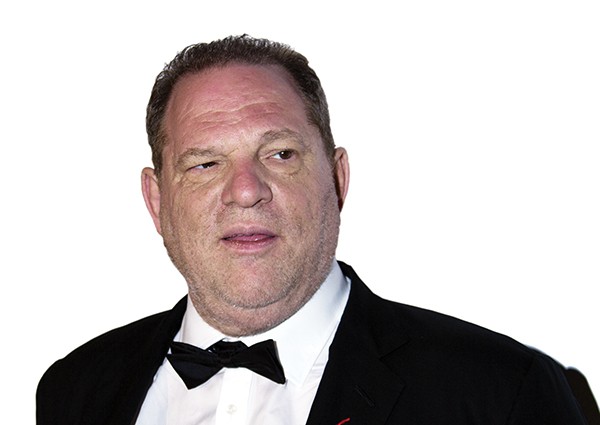It’s a given that men are dogs and pigs, but, my God, the description of Harvey Weinstein’s conduct was shocking to me — then I talked to my wife. In my naivete, I never realized this ugly conduct happens all the time. Melody was and is an attractive woman, which means that since she was 16, practically every man she’s ever known has hit on her, including a cop and a former teacher. She’s seen it all — flashers, gropers, masturbaters, heavy breathers, and aggressive advances from acquaintances and co-workers both young and old.
And her female friends said these encounters are common with them, as well. Everyone had a tale to tell. Some of Melody’s stories were too harrowing to repeat. Fortunately, she escaped these incidences unharmed. The 30 women who accused Weinstein of sexual abuse over 20 years weren’t so lucky. Weinstein’s victims include a Who’s Who of Hollywood actresses — Gwyneth Paltrow, Ashley Judd, Angelina Jolie — and Rose McGowan, who refused a $1 million hush-money offer and called out Hollywood talent agencies as being “guilty of human trafficking.” It only took one brave woman telling her story to The New York Times to open Pandora’s Box, so to speak.
Weinstein initially denied engaging in nonconsensual sex, but his unspeakable behavior was common knowledge at Miramax, the company he founded. Weinstein has reached seven settlements with other victims.
Weinstein’s predatory conduct was appalling because it was so disgusting. He invited women to his quarters and reappeared in a bathrobe, exposing himself. Ashley Judd was asked to watch him shower. Other unassuming targets were told that watching him masturbate would help their careers. Weinstein has been accused of giving alcohol to a minor, rape, and assault.
The bloated, bearded swine blamed his behavior on coming of age in the 1960s, when the rules were different. No they weren’t. Only in Hollywood could a dirtbag feel so entitled and powerful that women would surrender to his nascent charm. He had the power to make or break an actress’ career, and if rebuffed, he would go out of his way to punish them. After the Weinstein allegations, 59 more men in politics and entertainment have been accused of abhorrent sexual behavior, and the list is growing every day.
 Denis Makarenko | Dreamstime
Denis Makarenko | Dreamstime
Harvey Weinstein
For 20 years, viewers spent their mornings with Matt Lauer. After learning that he had a button under his desk to lock women in his office and pull the old Harvey Weinstein bathrobe routine, I feel duped. It’s like if Dick Van Dyke were arrested in a child pornography sting. Same goes for Charlie Rose, fired by CBS, PBS, and Bloomberg for making lewd phone calls and incidences of groping. Thoughtful and soft-spoken political analyst Mark Halperin, co-author of Game Change, masturbated behind his desk while meeting with a female colleague. The hot comic Louis C.K., writer and director of the classic movie Pootie Tang, did bits about masturbation in his stand-up act. Now we know he wasn’t kidding. Accused of exposing himself and asking women to watch him masturbate, his upcoming comedy special and a new movie release have been cancelled.
The list goes on: Kevin Spacey, Jeffrey Tambor, Dustin Hoffman, Garrison Keillor (!) for God’s sake. Bill O’Reilly paid out $13 million to five women. Former Fox News host Gretchen Carlson successfully sued Fox Chairman and CEO Roger Ailes for $20 million for “unwanted sexual advances.” Ailes took the easy way out and died earlier this year. Of course, there’s accused child predator and our probable new Senator from Alabama, Roy Moore, cruising teen hangouts to make new friends. He claims all of his accusers are lying.
We have obviously reached a tipping point in male-female relationships. The old dinosaurs are going down, and the push is finally on for women to be believed. But must we blindly believe all women? Case in point is Senator Al Franken and his accuser, radio personality Leeann Tweeden. On a 2006 USO tour in Afghanistan, when Franken was still a comedian, Tweeden said Franken forcibly kissed and groped her. She later wrote Franken, “grabbed my breasts while I was sleeping and had someone take a photo of you doing it, knowing I would see it later and be ashamed.” Franken immediately apologized and called for an ethics investigation on himself, which was smart, because it could force Tweeden to testify under oath. The photo mentioned was childish and sophomoric but contradicts Tweeden’s account. She is asleep in a cargo plane wearing a flack jacket while Franken’s hands are hovering over her chest while he smiles for the camera — obviously a joke — a stupid one, but a joke just the same. Tweeden was a regular on Sean Hannity’s nightly propaganda broadcast, and a Trump supporter. Sounds like a hit job to me, yet some are demanding his resignation. Which brings us to the most blatantly hypocritical pot-and-kettle dilemma. Over the past two decades, taxpayers have paid $17 million for hush money and to settle Congressional sexual harassment charges for 264 Congressional staffers and other legislative employees. One other question remains: When is Donald Trump going to sue those 20 women who accused him of predatory sexual behavior, like he promised?
Randy Haspel writes the “Recycled Hippies” blog.